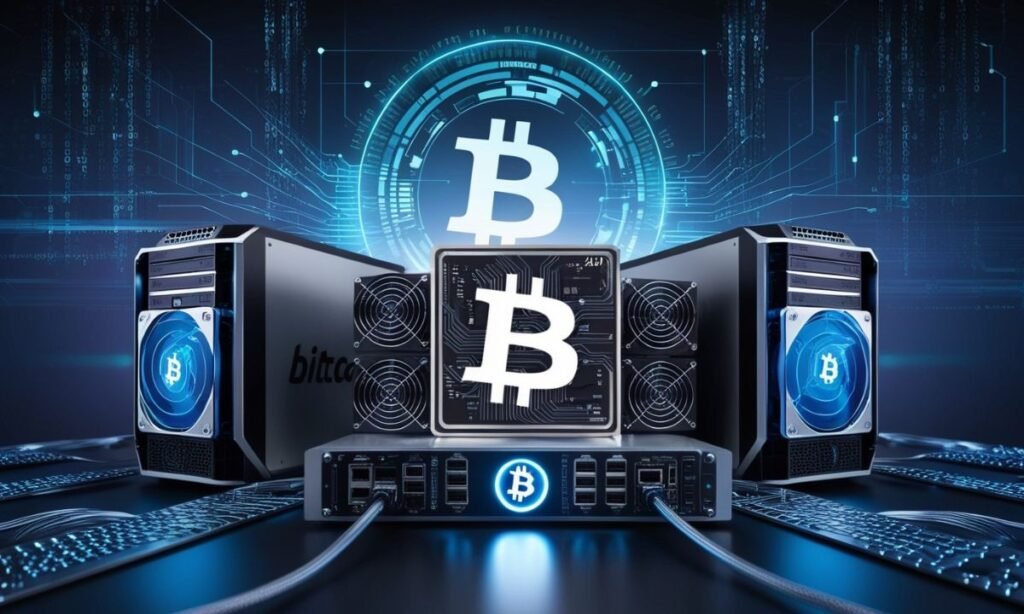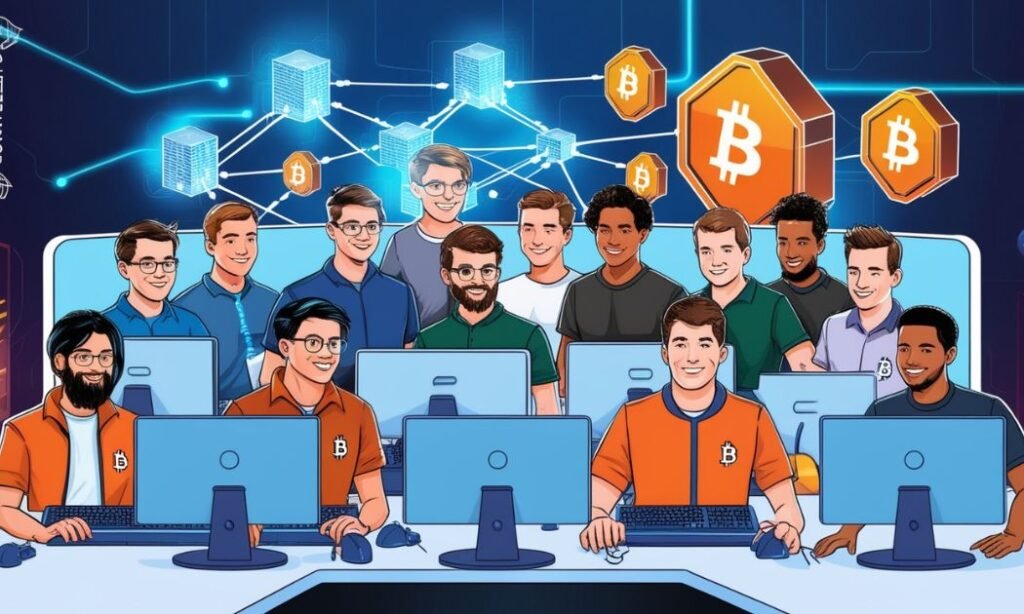Does Bitcoin Mining Work? Bitcoin mining is an exciting and highly technical activity, perhaps the most important in digital currencies. Having delved into this issue, I wish to express my understanding of the essence, requirements, benefits, and drawbacks of Bitcoin mining processes.
Key Takeaways
- The primary objective for miners is to confirm the validity of each transaction, put it on the Bitcoin ledger, and earn themselves some newly minted bitcoins.
- The mining process consists of confirming transactions, developing new blocks, addressing various mathematical problems, and appending the blocks to the existing blockchain.
- Due to the high mining difficulty level, specialized machinery, especially ASIC Miners, must be used for successful bitcoin mining.
- If other miners cannot generate bitcoins independently, achieving this goal is more accessible within a mining pool, which enhances the total computing power.
- By virtue of its mining, Bitcoin has impacted the environment, which has spurred debates on the need for such activities and advocates for renewable energy sources.
What is Bitcoin Mining?
The term ‘bitcoin mining’ means verifying transactions made using Bitcoins and entering these into the blockchain. This process contributes to the sustainability of the network while generating new Bitcoins.
In other words, whenever a miner verifies a block containing transactions, they receive independent newly joined bitcoins and the transaction fees earned from those transactions.
It may be claimed that it is like a lottery, with the only exception being that the miners must work hard to crack specific codes.
The Mining Process
- Transaction Verification: Any transaction involving sending bitcoins requires ensuring that it includes adequate funds and is valid in every mode. Miners usually do this.
- Creating a Block: Blocks are drawn up from the verified transactions. Each block comprises several transactions, an internal anchor to another block, and a non-repeatable digest.
- Solving the Puzzle: The miners are expected to utilize their processing abilities to tackle the complex math problems related to the block. Such a puzzle is built to be challenging and hence requires good power to crack.
- Adding to the Blockchain: A mini demo is created after a miner cracks the math solution, which is posted on the network. Other miners will then check the solution for accuracy, after which, if correct, the new mini demo is inserted into the chain of mini demos.
- Receiving Rewards: The miner who has managed to append the block is compensated with two incentives: generating several non-circulating bitcoins and the transaction payments embedded in that block.
Mining Hardware and Software
First, please note that you will need some specialized mining hardware and software to mine any cryptocurrency. In the early days of the network, the average miner could easily use a standard personal computer to mine. Mining has become challenging as the network has expanded. Currently, most efficient miners use Application Specific Integrated Circuits (ASICs), heavy-duty devices manufactured to perform only bitcoins mining tasks. Like every miner, the participants must also install California software on their PCs, allowing them to join the Bitcoin extreme. This software also helps administer mining activities and interact with other participants.
Types of Mining Hardware
- ASIC Miners: These are the most efficient and powerful Bitcoin mining hardware. They are dedicated continuous miners fashioned to have the highest hash rate, thereby solving more puzzles than any mining hardware alternatives.
- GPU Miners: GPUs were once the most mined item due to their price and efficiency. But Do not lie. They now mine other cryptos instead of bitcoins because bitcoins have become too complex to mine for them. However, GPUs are valuable for cryptocurrency and other coin mining activities like Ethereum.
- FPGA Miners: Field-programmable gate arrays (FPGAs) are very programmable devices but are for one-off use. They are efficient and flexible somewhere in between ASICs and GPUs.
Mining Pools
Due to the difficulty of mining, many miners have decided to join mining pools. A mining pool is a group of miners who combine their computing power to increase their chances of successfully solving a numerical puzzle.
Once the pool can mine a block, a predetermined or specific reward is paid to each pool member for the computing power utilized by each member. A mining pool can be an excellent option for making money in bitcoins without spending money on bulky mining equipment.
How Mining Pools Work
- Pooling Resources: Pool members contribute their power, making it easier for the team to solve the resource-intensive puzzles needed for mining.
- Reward Distribution: If such a block is successfully established, the benefit accruing from the mining is proportionately shared amongst the pool members in terms of the computational effort contributed. This way, even the smaller miners can earn some bitcoins from mining occasionally.
- Types of Mining Pools: Mining pools also come in different types, whereby some focus on proportional pools, others on pay-per-last-N-shares PPLNS or solo pools, among other reward distribution methods.
- Pool Management: In terms of management, most mining pools have a pool manager who operates the pool, farms the members, allocates responsibilities, and ensures that all pool members are rewarded appropriately.
Benefits of Joining a Mining Pool
Joining a mining pool is advantageous for smaller miners who may not have the resources to compete individually. It allows them to:
- Increase Mining Efficiency: Through pooling their resources, the miners work collaboratively and can solve the puzzles faster, increasing their chances of earning rewards.
- Receive Regular Payments: Mining pools provide more frequent payouts, allowing the miners to earn monetary returns by leveraging, especially on small payments.
- Access to Advanced Technology: A number of tCAT pools provide suitable, quality mining hardware and software for better overall mining performance.
The Role of Mining Difficulty
The mining difficulty represents how easy or hard it is to gain the right to create the next block. It revises approximately every two weeks concerning the total computational capability of the network.
The difficulty increases as more miners enter the pool and more computing power is incorporated into the network. This guarantees that, on average, every 10 minutes, a new block is produced in the chain, and new bitcoins are released for use.
The Importance of the Blockchain
The blockchain is the actual infrastructure that allows BTC mining. Its functioning can be compared to an ordinary road book, but this book keeps a history of all the business operations performed in Bitcoin.
Each block consists of many transactions, and once it is filled with transactions, it is added to the chain. This feature of the system is the drill that secures the trust over the distributed ledger technology.
Environmental Concerns
One notable area of concern regarding Bitcoin mining is the environment. The process requires enormous amounts of electricity, which can cause problems such as carbon footprints and sustainability.
Many miners are exploring renewable energy sources to help generate power for their activities. Still, the mining arguments regarding pollution are unending.
Is Bitcoin Mining Legal?
Bitcoin mining is mainly permitted in the USA, although this may change depending on the state. Some have embraced it, but a few have restricted it. It is essential to understand local laws and regulations regarding the operation of a mining company.
The Future of Bitcoin Mining
This is also true for bitcoin mining, tending towards a more socially responsible approach.
There are new developments in mining, such as better mining equipment and support for greener mining technologies.
Moreover, a growing trend of cryptocurrency investors has translated into more miners competing for a shrinking slice, thereby threatening the viability of mining businesses.
How to Start Bitcoin Mining
- Research: Learn how Bitcoin mining functions and the tools it requires. Acclimate yourself to mining difficulty, hash information, and mining pools.
- Choose Your Hardware: Find out if buying ASIC miners and GPUs is worth it or if you want to purchase mining pool shares. ASIC miners provide the most hashing power in terms of bitcoin mining.
- Set Up Your Mining Rig: Once ready with the hardware, build your mining rig. Make arrangements for a constant internet connection and good hardware cooling.
- Download Mining Software: Select and download the relevant mining software that corresponds with your hardware or the mining pool you intend to join.
- Join a Mining Pool: If you wish to take up a mining pool, choose one suitable for you and create an account.
- Start Mining: All the preparations have been made, and now it is possible to commence the mining process! Keep track of the changes and adapt yourself/reassess the strategy as needed.
My Opinion
Bitcoin mining is intricate and demanding, but it is also very profitable. This process requires considerable investment in hardware and electricity, but ample opportunities exist for profit. Anyone interested in getting into this exciting activity must have a basic idea of the mechanics of bitcoin mining—how it is done, what equipment is used, and what obstacles arise.


